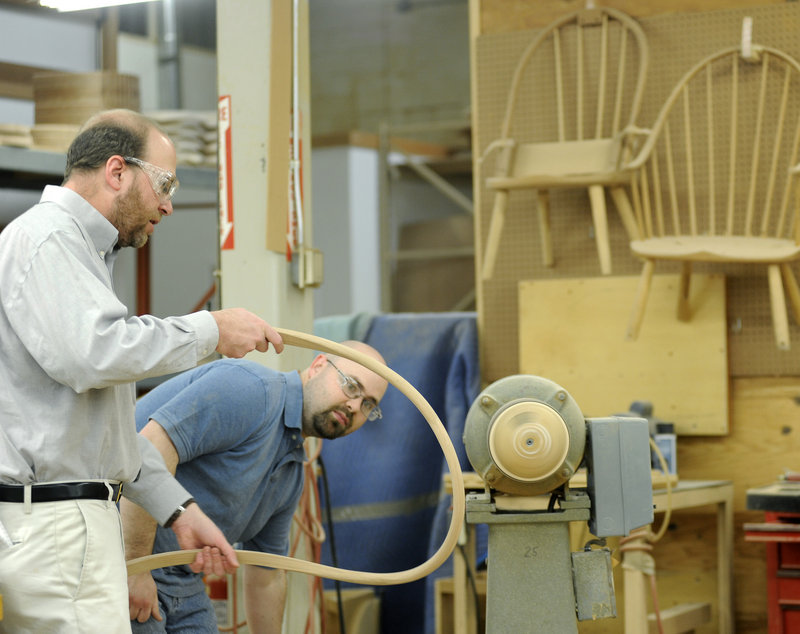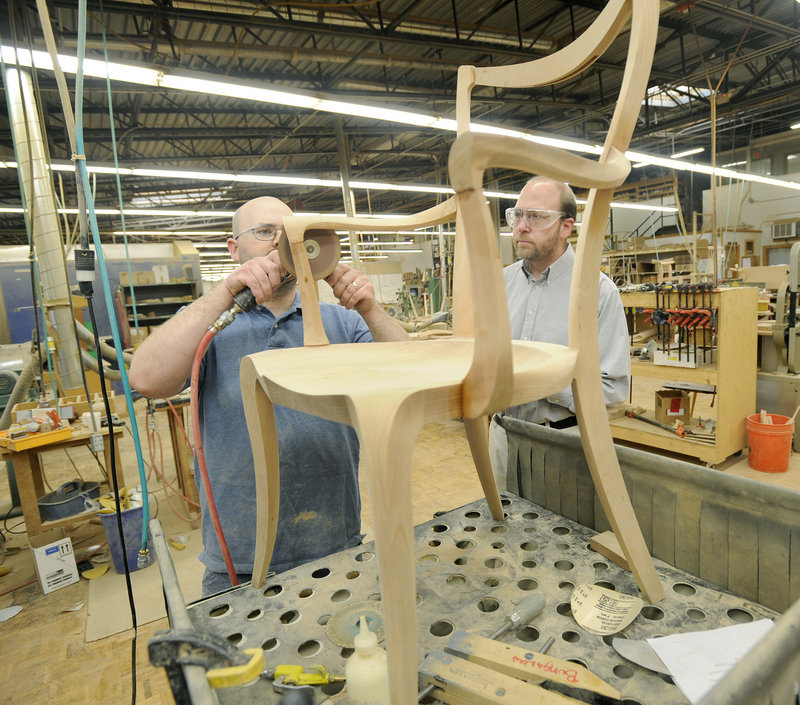AUBURN — To me, the dining chair looked done.
It wasn’t stained or finished, but other than that it was fully assembled – arms, back, legs, seat. I would have been happy to take it home.
But cabinetmaker George Colby Jr., an 11-year veteran of making furniture at Thos. Moser Cabinetmakers in Auburn, told me it would take another three hours or so of hand labor before the chair could go off to the finishing room.
“See how rough that seat feels?” asked Colby, 30, as he motioned for me to run my fingers over the wood. Felt pretty smooth to my untrained fingers. “That’s very rough; we have to work on that.”
Colby took a couple of passes over the wooden seat with an air grinder – a loud, spinning disc that power-sands wood with only the slightest amount of pressure – then gave the tool to me.
He told me to smooth out the roughness while keeping the rounded parts of the seat round and the flat parts flat. I think I got a little mixed up, because with just a tiny shift of my hands, I was suddenly making the flat part a little rounded.
“Oh, you want to maintain the flat surface. We don’t want it to look beveled on the edge,” said Colby.
He quickly took the grinder back. “That’s OK. It’ll take a little extra work, but we can fix that.”
I felt bad. I didn’t want to add time to a project that Colby had said would take him about nine to 10 hours. From the time he gets the rough-cut wood to the time the chair is ready to have a finish applied, that’s how long Colby and other cabinetmakers (the Moser company title for furniture makers) are supposed to spend on this particular chair.
I also felt bad later, when I read in the Moser catalog that the Pasadena dining chair I had worked on with Colby retails for $2,500. No wonder it takes nine hours or more to make one.
Colby told me how he does sanding, grinding and “sculpting” of the chairs with power tools and hand tools, including chisels and mallets he made himself. After the chairs are assembled, there are little lines and globs of glue to be sanded or ground away.
There is also a lot of shaping of the wood, which has to be done in tiny increments. The Pasadena chair in particular is full of curves and interesting angles that can’t be attained by simply nailing straight pieces of wood together.
“When it leaves me to go to finishing, it’s got to be completely ready – no dents, scratches, marks or defects of any kind,” Colby said.
FROM APPRENTICE TO EMPLOYEE
Founded by former Bates College professor Tom Moser in 1972, Thos. Moser Cabinetmakers is known around the country. Its furniture is sold by catalog nationwide, and the company has showrooms in Freeport, Boston, New York City, Washington, D.C., Chicago, Los Angeles and San Francisco.
Colby has never wanted to do anything but woodworking. Luckily for him, he grew up in New Gloucester, right next to Auburn. In high school, Colby struggled, and to earn needed credits he took a woodworking class and became hooked.
He came to Thos. Moser as a teenager and was hired to do entry-level work. He eventually got into the company’s apprentice cabinetmaker program and spent more than four years learning the craft.
“Woodworking is really all I’ve ever wanted to do, and I’m so lucky to have had this chance,” he said.
Although about 65 people are making furniture at any one time at Thos. Moser, the workers are spread out. Most of the time I was with Colby in the chair area, there were only a half-dozen or so other workers visible, though many people passed through the area on their way to somewhere else.
Besides all the tool benches and power tools, the two things that stuck out for me were all the hoses hanging from the ceiling and the wooden parquet-style floor. The wood floor is “more forgiving” than concrete, so dropped furniture pieces are less likely to crack, Colby said.
The hoses are for ventilation and are meant to suck wood dust out of grinders, sanders and other machines. Respirators are recommended for anyone who does sanding and grinding. I didn’t wear one. I can still taste the dust in my mouth as I write this.
HANDLING ‘AGGRESSIVE’ TOOLS
Colby had me do some of the work that he did early in his career with the company. It consisted of gluing and shaping the back piece for Moser’s signature piece, known as “the continuous arm chair” ($1,325).
The chair has one continuous arm that starts on one side, stretches across the back and becomes the arm on the other side.
The piece is made by gluing together nine or 10 layers of laminate, then bending, shaping, sanding, routing and grinding the piece until it looks like a curved tree branch that has been worn smooth by years of wind and weather.
Colby had a piece that was bent into the right shape but still pretty straight on the sides – not rounded – and with lots of glue showing. He showed me how to hold the piece against a power “balloon” sander to smooth it off.
He warned me not to slip, because the sander is “pretty aggressive,” and he still has scars from past battles with it.
Then he told me to maneuver the piece around a power router to scrape glue off. He warned me to keep my hands away from the blade, as this was one of the more dangerous operations in the shop.
I successfully held the piece against the router for about 30 seconds and felt I didn’t want to push my luck any more. So I handed the wood to Colby.
During another step, Colby put the continuous arm in a grip and started scraping it with a rasp. I could see the big curly shavings of wood that the rasp was creating. Since this wasn’t electric, I felt it would be safer for me, that I’d be more in control.
But because it wasn’t electric, my arms had to power the rasp. And my arms aren’t very powerful. I barely grazed the wood.
“You’ve got to use a little bit more gumption,” Colby told me.
Words to live by.
Staff Writer Ray Routhier can be contacted at 791-6454 or at:
rrouthier@pressherald.com
Send questions/comments to the editors.





Success. Please wait for the page to reload. If the page does not reload within 5 seconds, please refresh the page.
Enter your email and password to access comments.
Hi, to comment on stories you must . This profile is in addition to your subscription and website login.
Already have a commenting profile? .
Invalid username/password.
Please check your email to confirm and complete your registration.
Only subscribers are eligible to post comments. Please subscribe or login first for digital access. Here’s why.
Use the form below to reset your password. When you've submitted your account email, we will send an email with a reset code.